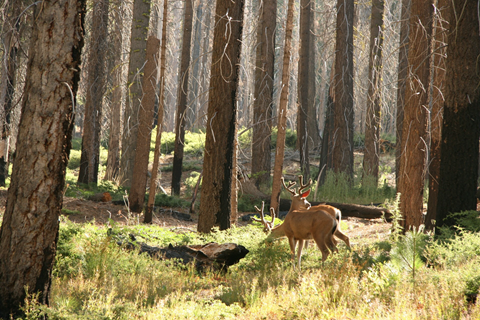 The Wilderness Medical Society held its Annual Meeting in Snowmass, Colorado from July 24-29, 2009. The meeting was very well attended and once again demonstrated that the Society is the hub organization devoted to advancing the science and clinical practice of wilderness medicine. The format this year was to add a great number of presentations suggested by, and in many cases, delivered by members.
The Wilderness Medical Society held its Annual Meeting in Snowmass, Colorado from July 24-29, 2009. The meeting was very well attended and once again demonstrated that the Society is the hub organization devoted to advancing the science and clinical practice of wilderness medicine. The format this year was to add a great number of presentations suggested by, and in many cases, delivered by members.
Wayne Askew, Ph.D. and his colleagues taught on the topic of planning and preparing food for wilderness expeditions. Their goals were to allow the participants to develop an appreciation for the role that food and food planning plays in successful and enjoyable backcountry recreation; understand the similarities and differences between small and large group food planning; estimate energy and other nutrient requirements for individuals and groups; review guidelines for planning nutritional support for backcountry expeditions and recreation; and observe demonstration of recipes and preparation techniques for some useful backcountry food items.
A number of terrific observations were made. In no particular order:
1. Food planning is very important in outdoor activities, with emphasis on the word “planning.” One can enhance backcountry travel and survival with good nutrition.
2. Food planning is also important for morale. If people are hungry, malnourished, or unsatisfied, they are not “happy campers.”
3. The food planner for a trip or expedition should be chosen carefully, and should take care to take into account the dietary preferences of the participants.
4. Energy requirements for specific activities related to physical performance and caloric expenditure can be calculated and taken into account for food and meals planning.
5. There are sometimes foods for special needs (e.g., such as allergies, deficiencies, diseases, etc.). While many of the participants can handle their own needs, whomever is managing food should be aware.
6. There are persons who specialize in wilderness nutrition planning. They advise expedition planners on food, water and logistics; plan menu and food supplies for backpackers, wilderness tour groups and expeditions; assist in search and rescue operations; consult with food companies specializing in backpacking foods; and cook food.
7. If a person wants to accomplish nutrition planning, he or she should have a basic knowledge of human nutrition, understand human physiology and the role of food nutrients in extreme environments, know how to utilize food item selections to provide recommended nutrient intakes, and be a good cook in the outdoors.
Food planning by definition means thinking about food in advance. Dr. Askew and his colleagues recommended answering the following questions:
How much room is in your pack?
How much weight can you carry?
How long will you be traveling?
Where are you going?
How much fuel will you need and will you have access to water?
With whom will you be traveling?
Factors that affect food choices in the backcountry are food preferences; weight, perishability, taste and texture of foods; space in the pack; duration of trip; availability of water and fuel for food preparation; environmental conditions; experience with food preparation; special dietary needs; and personal beliefs.
This was a terrific educational experience, with terrific information such as this Planning Guide Nutritional Standards for Backpacking Food for One Person for One Day, based upon U.S. Army AR 40-25 Nutritional Standards for Operational Rations:
https://www.army.mil/usapa/epubs/pdf/r40_25.pdf
Energy (kcal) 3600 (will vary depending upon activity level)
Protein (g) 100
Carbohydrate (g) 440
Fat (g) 160
Vitamin A (RE) 1000
Vitamin C (mg) 60
Vitamin E (mg) 10
Calcium (mg) 800
Iron (mg) 18
Sodium (mg) 5000-7000
Fiber (g) 20-35
Finally, consider the following recipe for energy bars. This is one way to prepare less expensive and more nutritious (than store-bought) bars for personal use. As recommended by Askew and colleagues, you can be creative with this recipe, and use a variety of fruit, nuts, and grains. It is sufficient to make approximately 20 small bars.
Preheat oven to 350°
½ cup brown sugar
1 egg
¼ cup peanut butter
2 tsp vanilla extract
½ cup apple juice (unsweetened)
1 cup whole wheat flour
1 cup quick cooking oats
½ cup wheat germ
½ tsp baking powder
½ tsp baking soda
¼ tsp salt
½ tsp ground cinnamon
½ cup dried fruit (raisins, apricots, dried cranberries, etc.)
½ cup chopped nuts (walnuts, almonds, peanuts, etc.)
½ cup semi-sweet or dark chocolate chips
Mix dry ingredients in one bowl, wet ingredients and added “goodies”
(chocolate chips, raisins, nuts, etc.) in another, then combine. Spread the batter over a lightly greased cookie sheet about ½ -¾ inch thick. Use a spoon dipped in hot water to press the batter into the sheet and shape to the proper thickness. Bake for 10-15 minutes. Allow the pan to cool completely before cutting into bars. The bars can be refrigerated or frozen for longer shelf life.
Nutrition Information: calories 140, protein 5 grams, carbohydrates 20 grams, fiber 2 grams, fat 6 grams (saturated 1 gram) (% of calories from carbohydrates = 52%)
Reprinted with permission by the Author from Healthline.com


